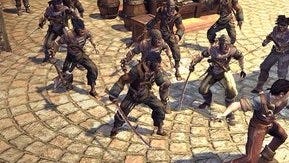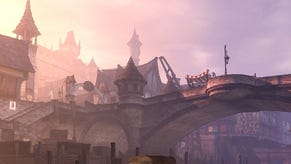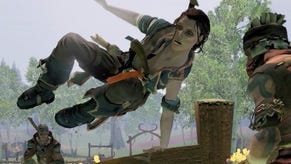Fable 2
Shock and orbs.
Chief amongst these is the morality system, a far subtler beast than the original Fable's. There are still quests terminating in a simple moral choice, yet the game's also watching you when you least expect it. Early on you're asked protect a dog - yes, that dog - from a beating at the hands of a local urchin, but there's more going on than a combat tutorial. Knock the bully away and the dog is saved, but if you choose to give the urchin a good kicking (and you can be surprisingly brutal) the game will take note. Once again, your morality will ultimately shape your appearance.
Bowerstone's cobbled streets also allow Molyneux to show off one of the game's most controversial features: the breadcrumbs. Lose your way in Fable 2 and a glimmering path will eventually appear, showing you the route to your next target. The system may seem doomed to turn a free-roaming adventure into Perfect Dark Zero, but, as with the orbs, a lot of method's gone into this madness, and something we instinctively disliked turned out to be far cleverer than expected.
As in PDZ, breadcrumbs can be switched off entirely, and Fable 2 reacts to how you use them, and tweaks them accordingly. But there's more: just as the game seems to be turning into Dickensian Scalextric, your dog arrives, and the whole system gets a lot more flexible. If the breadcrumbs are there to keep you from getting lost, the dog is there to give reluctant players the confidence to explore. Low maintenance and utterly convincing as an animal, if there are secrets, treasures, or an alternative path nearby, your dog will alert you to them with a helpful bark, and the breadcrumbs will always be there to lead you back to your real destination again.
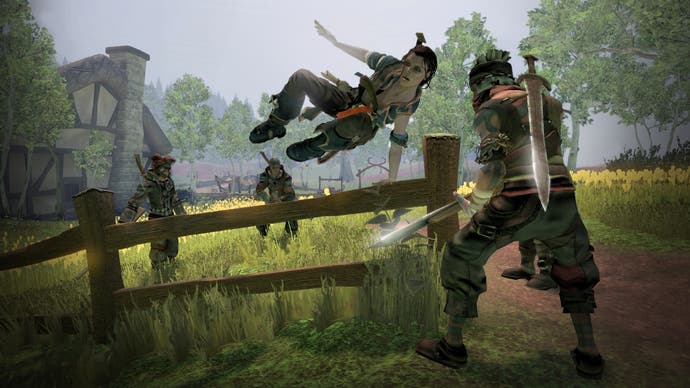
Again, like the co-op, this initially seems unnecessarily complex: how many other games give you conflicting mechanics that lead you down a set path while also tempting you off it? In implementation, however, it's surprisingly effective at encouraging exploration without allowing you to get lost, and it's as pure an indicator of Fable 2's design goals as you could wish for. Lionhead wants to have it both ways with this game: it wants something that's simple for those who like their games short and sweet, while also having the optional depth for those who want something more involving. It's studied the things that make casual gamers uncomfortable, and created tools to allow them to feel safe, hopefully without ruining everyone else's fun too.
If the breadcrumbs make that intent clear, it's combat that allows insight into how the designers are faring - and, happily, combat may be Fable 2's masterstroke. "One-button fighting" may not sound very involving (and the name isn't misleading: melee, ranged weapons, and magic each have their own face button, and it's perfectly possible to play through the game at that level if you wish to) but deeper options are still available.
Take sword-fighting: a single press triggers a basic swipe, but moving the left stick while holding the button down gives you a flourish move: you'll do more damage, but be more vulnerable. Tapping in time with the rhythm of the music also enhances attacks, as does the game's context-sensitive system, which brings the environment into play depending on where you're standing. Spells and ranged weapons have the same depth - guns and bows can auto-target or switch to a manual aim, and a variety of different spells can be selected by varying the length of the button press, aimed with the left stick, or used in combination.
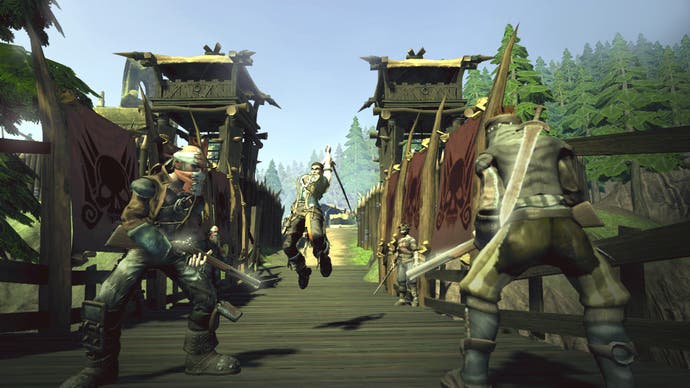
Our combat demo is a fight through a misty swamp, with enemies lurching out of the ground and attacking in groups. It's a genuine thrill to battle them, and the way the system allow you to switch weapons with no planning meant we were quickly chaining attacks together, finishing off nearby nasties with flourishes, then taking out ghouls in the distance with the shotgun. There are surprises everywhere, most of them delightful, such as when a force-push spell allowed us to finish off six skeletons at once by flinging them against a wall, and ultimately it's far more satisfying than you may expect from combat in a title that has so many other items on its agenda.
Slowly, then, Lionhead's game is starting to take shape out of the mess of inter-linked XBLA distractions and whirlwind marriage opportunities. Furthermore, the shape it's starting to take is a familiar one: Fable 2 is about as close as you can get to a single-player MMO. Not only does it share the same preoccupation with character evolution and customisation (which will be a lot deeper this time; Molyneux admits that many players treated the original's options as mere "Easter eggs"), it also uses a lot of the same formulas and conventions, from the way it doles out its quest-givers, to the evolution of the original game's property-buying, which now theoretically allows you to own every building in the game.
Fable 2 is as ambitious as the first game promised to be, but this time Lionhead is taking on additional challenges: trying to make this for as broad an audience as is humanly possible, without alienating anybody along the way. That sounds close to impossible, and once again, there are signs that the clutter of sheer creativity on display may result in a game that's twice as wide as it is long. But the difference this time is that we're playing the most interesting features instead of just hearing about them. The first Fable was a brilliant idea that was split somewhere between the game disk and its creators' imaginations, whereas the sequel is already coming alive on screen. Maybe Peter Molyneux has got better at planning after all.
Fable 2 is due out exclusively on Xbox 360 in October.






